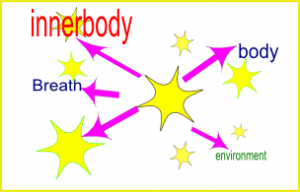Meditation Defined
Meditation has many purposes. To meditate correctly is profoundly powerful. It builds your depth and skill set for being Present in life. It is where you practice Presence correctly without the distraction of daily life happening. To have a meditation routine is a powerful way to assist you with habit formation of correct Presence. It assists your unconscious mind (pillar No5) to build the nuances of the habit. Even after phase 3 Abiding Awakening to keep up a meditation routine helps you at many levels. These topics are discussed in the Laws of Grace course more extensively.
If you have a meditation routine then when life's tests and unpleasant stuff happens you can draw on your resources built up through the growth of this practice. Meditation in this site is seen only as a small subset of your Presence practice. To be phase 2 non-Abiding or higher means you are actively doing your best to be Present as often as possible throughout your day.
From a state of meditation, Inquiry is extremely effective as the deeper unconscious levels can be accessed, felt, heard (allowed to be expressed in your consciousness) and then released and transformed into something that is of assistance in your life.
Since I hit phase 3 Abiding Awakening in early 2008 people have often asked me "How often do you meditate"?
I tend to reply "I don't ever stop meditating" as the short answer. This often confuses them as they separate meditation from what it is hopefully pointing to. This clearly indicates they are in phase 1 Got it Lost it. The point to pillar No1 Correct Presence Practice is that it becomes a default way of living through all your day.
Defining meditation approaches
1: Inclusion and multiple focus meditation
Meditation in this website is defined as the simple process of being aware through Correct Presence Practice. It is pillar No2 inclusive of all of you and allows everything to be as it is as many teachers like to say.
 To be aware of what is going on for you internally and externally. As you observe and feel you allow what it is that is going on within you to be just as it is. No need to change anything! It really is that simple.
To be aware of what is going on for you internally and externally. As you observe and feel you allow what it is that is going on within you to be just as it is. No need to change anything! It really is that simple.
What this consciously choosing to be aware of leads to is the state of Presence, and then step 4 the impersonal awareness of the Divine (when God deems that is OK). Things are allowed to be as they are. Your attention is spread initially into more than one direction to include all your body and inner body.
This has the effect of immediately dis-empowering the internal mental dialogue. The internal conversation is included in the picture. Thus you do not need to fight your mind. As you focus on more than one aspect you are also able to notice what connects them. This is the great secret to why being correctly Present means mind chatter is not an issue.
This internal space allows these aspects to exist. This space can also be called awareness, stillness, void, consciousness, non-manifestation as the common link. This is represented in the diagram as yellow stars. As you focus on this as part of your consciousness you will notice this is your Presence. Notice how it permeates all these other things; your mind, body, breathing, the chair, your feet… everything.
To experience this there is several step-by-step videos in all of the Reiki / Golden Ray healing and the Correct Presence Practice online courses. The Laws of Grace course has the biggest variety of meditations as that is the epic-sized course.
2: Single focus meditation
The second approach is the intentional single-point focus. The intentional focus is usually where the person focuses their mind’s attention on something. Eg: mantra, breath, third eye, body sensations etc. The idea behind these meditations is to hone your focus and ignore your mind's internal dialogue. If you get distracted by your mind you re-focus on the single item.
From this focus, you will eventually drop into deeper states of meditation until your mind distracts you. The shortcoming with this form is that there is only one point of focus.
 This focus should be the gateway to Presence, the real you. But if you keep saying a mantra as a focus this will not occur, you may be able to sense it but the one-pointed focus means it is not the actual focus. This form of focused meditation does have some uses and can be mixed with method one that is used here. It has uses for things like healing and developing photographic memory.
This focus should be the gateway to Presence, the real you. But if you keep saying a mantra as a focus this will not occur, you may be able to sense it but the one-pointed focus means it is not the actual focus. This form of focused meditation does have some uses and can be mixed with method one that is used here. It has uses for things like healing and developing photographic memory.
In my third year at university, I developed powerful photographic memory from using this focus style meditation. Ironically my whole year became photographic although my focus was only on my university subject content. I could recall all conversations and events in vivid detail. This points to the holographic nature of the mind and how application in one area will impact all areas.
Why 'TM' Transcendental Meditation fails
What you can do about it. Evidence speaks for itself.
Mantra style meditations like TM (Transcendental Meditation) fail as they simple violate the core Laws of Grace and the 9 pillar framework structure. To focus on a mantra means you are forcing the mind to recite words in your head. Your mind is a tiny subset of who you are. Your mind will never Awaken so running a sentence over the top is ineffective. The only benefit of putting time into TM or mantra-style meditations is to develop your attention span. However, this is a poor method to use. Correct Presence Practice based meditations and in-life practice are far more effective.
I've never personally met an individual who lives in phase 3 Abiding Presence who is a practitioner of mantra meditations. The bandwidth of these styles of meditation are very narrow and lower mind limited. That is the ego-mind level of vibrational frequency. I'd like to be proved wrong with this, and then ask a lot of questions to see how they did reach their Awakening if it is phase 3 Abiding Awakening as defined in this Laws of Grace methodology.
Meditation: other key points
Try the below hints and experience for yourself. Your experience (ie: pillar No3 rules of evidence) is what counts not other people's theories and rigid practices:
♦ Posture. Sit up comfortably.
⊗ Forcing a stiff straight spine is pointless if it hurts and makes for a distraction. Comfort is more important here than an ideal posture. Presence is the objective. Presence is Awakening, not the position of your spine.
♦ Lying down is also OK, especially if you have a sore back if you stay awake. However, falling asleep can be an issue. It may take practice. Sleep isn't conscious so it does not count, in this case it's a nap. You obviously need a sleep catchup, or you have gone into avoidance.
♦ Routine. A set time and place for 20 to 60 minutes is always good. But forcing it can be counter-productive. You may go through cycles of meditating daily and not. Keep a Presence dairy and notice how it affects your practice.
♦ Mornings, after a shower is always good to set your day up, especially if working. Even after a quick coffee if it helps you to be alert. It's about Laws of Grace, entering Stillness / Presence.
♦ A quick meditation after getting home can also be of great assistance to clear your day.
⊗ Meditating just before bedtime can disrupt your entry into sleep and the brain’s circadian clock which regulates sleeping patterns, so if this happens have a break before bed (at least an hour). Meditation affects the brain wave cycles, which is what dictates good sleep cycles.
⊗ Nodding off to sleep when meditating. This topic can be complex, but in summary it's either 1. you need more sleep and self-care is important. 2. Avoidance by your ego (psychological structures). In this case, it may persist until you can meditate properly and not doze off into delta (deep sleep) brainwave patterns. This may require some coaching feedback to address the issue.
⊗ The key distraction with meditation is what people want from it. There is very little use in being able to access deep levels of Presence in formal meditation and yet be lost in egoic programming the rest of the time. If you only practice Presence when you meditate and it is not maintained in life's daily activities means your meditation efforts are of little use. You will stay in Got it Lost it phase 1 of the Awakening journey if this is the case. Ask yourself the serious question what do I want and what will I do about it?
⊗ Another trap is if you are sitting for hours a day in stillness and blissful meditation. This is an indicator that you are avoiding the world and your real self.
As mentioned in the Levels of Awareness page, if you are in the abiding Presence phase you will be moving back into the world as a grounded human being. Why? Because you realise what you are, you will not avoid being in the world, as your realisation can never be lost. You will have the ability to now face all of life's good and bad experiences without preference or avoidance nor losing your center as Presence.
♦ Once you have re-charged yourself, it is time to go back into the world. Apply Correct Presence Practice as best as possible. The Laws of Grace apply all of your not-asleep hours 7x365 if you truly want to live in non-stop Awakening.

